Achillea millefolium (syn Achillea lanulosa)
[ah-KEY-lee-uh]
Each Month I will pick an herb I have used, grows in my area, or that I find just plain interesting. If you wish to see a particular herb featured for a certain month, feel free to leave a comment. If I get enough comments for one particular herb or plant, (also can be a tree) I will then feature it for the month.
Family: Compositae
Names: milfoil, thousandleaf, sneezewort, sanguinary, nosebleed, soldier’s woundwort, stop bleeding herb, sanguinary, thousand leaf, thousand-leaved clover, bloodwort, wound herb; Seven year’s love, old man’s mustard, military herb, old man’s pepper, thousand seal, hundred-leaved grass, arrow root, eerie, ladies’ mantle, knyghten, stanch weed, field hops, gearwe, yarroway, devil’s plaything, snake’s grass, death flower, stanch griss; Carpenter’s Herb, carpenter’s grass, gordoloba, green arrow, dog daisy, Plumajillo; herbe des charpentiers, millefeuille (French); Schafgarbe (German); achillea, millefoglie (Italian); Krwawnik Pospolity (Polish); Chiliofila (Greek)
Description: low-growing leaves, with straight flower stalks. A height up to 3 feet and a width to 1 foot. The flowers are tight groups of tiny, ¼-inch white flowers, clustered in 3- to 3-inch umbels on stiff, upright stems. Leaves are very finely divided and feathery on stems to 8 inches long, becoming smaller toward the top of the plant. It blooms from June to August.
Cultivation: A perennial to Zone 2. It germinates in 10-14 days. Needs light to germinate. Prefers well drained, fairly dry soil. Will tolerate poor soil and is very drought resistant. In the west it only needs to be irrigated every 2-3 weeks; drip irrigation is best. If the soil is really poor then fertilize with manure first. The ideal germination temperature is 78-80F. pH is 4.2-7. Requires full sun and will become straggly in shade. Seeds germinate in 10-20 days are ready for transplanting in 8-12 weeks. Divisions are done in early spring or late fall. Divisions are easy to do but somewhat time consuming to plant. Seedlings are planted out in late spring or early summer. Divisions are planted when they are done in fall or early spring. Spacing is 12-18 inches in the row and the rows are 24-30 inches apart. Blooms start the second year. The flowers are harvested as they start to bloom in summer. The flowers will continue to bloom for several weeks. As flowering begins the top growth up to 8 inches long is cut off and dried in a thin layer. The center of the bed dies back after about 5 years and will need replanting with fresh root division. Yarrow flowers dry readily in 3-5 days. They are 65-70% water.
History: Achilles reputedly used yarrow to heal wounds of the Greek troops during the Trojan War, hence its botanical name. It has been used for this purpose for centuries and in Scotland a traditional wound ointment was made from yarrow. The Anglo-Saxons named yarrow gaeruwe, from gearwian,meaning to Prepare” or “to treat”, referring most likely to its curative properties. Other names, which generally describe yarrow’s ability to stop bleeding, include soldier’s woundwort, knight’s milfoil and herba militaris. In Medieval times, yarrow leaves were tolled and put up the nose to stop bleeding. Its finely divided leaves were the reason for another name, milfoil meaning “many leaves.” Druids used yarrow stalks to divine seasonal weather, while the Chinese cast the I Ching oracle with them to determine the future.
In the Middle ages the name was Supercilium Veneris or the “eyebrow of Venus”. Historically plants named after goddesses have been healing remedies for women. Yarrow was among the sacred herbs accompanying the dead on their journey in the middle east. In the Orkney Islands yarrow is widely used for dispelling melancholy. It is an important herb when healing someone burdened by troubled emotions, helping cleanse them of an unhealthy sorrow or a depression which has lasted too long. Albertus Magnus uses yarrow in combination with nettles to treat fear and self-negation. Yarrow was reportedly the first herb placed in the baby Jesus’ hand, perhaps to signal both his healing powers and vulnerability. Yarrow is one of a handful of plants call allheal in the English herbal tradition. In America it is the “life medicine” and general panacea of the Navajos. People used yarrow as an astringent and made a salve of it to heal sores. Native Americans poured an infusion of the plant tops into the ears of those with earaches, and pioneers drank it for everything from urinary problems to head colds.
Constituents: volatile oil with variable content (azulene—up to 51%, borneol, cineole, terpineol, eugenol, trace of thujone, linalool, camphor, sabinene, chamzulene); sesquiterpene lactones, flavonoids, saponins, sterols, glycoalkaloid (achilleine), alkaloids (acilleine); polyacetylenes; triterpenes; salicylic acid; coumarins; tannins, sugars
Properties: anti-inflammatory, antipyretic, antirheumatic, antiseptic, antispasmodic, astringent, carminative, cicatrisant, diaphoretic, digestive, expectorant, hemostatic, hypotensive, stomachic, tonic.
Energetics: bitter, spicy, neutral
Meridians/Organs affected: lungs, liver
Medicinal Uses: Due to the flavonoids they contain, yarrow flowers encourage circulation, lower blood pressure and help stop bleeding anywhere in the body. A couple of cups of hot yarrow, peppermint and elder flower tea is an old remedy for reducing fevers and treating colds, measles, and eruptive diseases. It also helps relieve urinary tract infections and stones. The tea benefits the kidneys. Cramps and rheumatism are treated with the tea, as are intestinal gas, diarrhea, anorexia and hyperacidity. In China, yarrow is used in poultices and to ease stomach ulcers. It is said to stop excessive blood flower especially well in the pelvic region, so is used to decrease excessive menstruation, postpartum bleeding, and hemorrhoids. Chewing the fresh leaves relieves toothache. Yarrow contains a chemical also present in chamomile and chamazulene, that helps relax the smooth muscle tissue of the digestive tract, making it an antispasmodic.
Yarrow can be taken in the form of herbal tea, tincture, fresh juice or medicinal wine. It can be used in a bath or on compresses. Sensitive people should perform a patch test before using the fresh juice on their skin. The tea is most effective when ingested in small sips throughout the day. A course of treatment with Yarrow should not last over four weeks, during which time the patient should avoid wine and coffee if possible. The fresh juice has a stronger effect than the tea. Two animal studies show yarrow protects the liver from toxic chemical damage. And a scientifically conducted trial in India showed yarrow helps treat hepatitis.
Aromatherapy Uses:
EXTRACTION: essential oil by steam distillation from the dried herb
CHARACTERISTICS: a dark blue or greenish olive liquid with a fresh, green, sweetherbaceous, slightly camphoraceous odor. It blends well with cedarwood, pine, chamomile, valerian, vetiver and oakmoss.
USES: Skin Care: acne, burns, cuts, eczema, hair rinse (promotes hair growth), inflammations, rashes, scars, tones the skin, varicose veins, wounds Circulation, Muscles and Joints: arteriosclerosis, high blood pressure, rheumatoid arthritis, thrombosis Digestive System: constipation, cramp, flatulence, hemorrhoids, indigestion Genito-urinary system: amenorrhea, dysmenorrhea, cystitis and other infections Immune System: colds, fever, flu, etc. Nervous System: hypertension, insomnia, stress-related conditions.
Toxicity: Reports that large doses cause headaches, dizziness, and even light sensitivity in some people, although this is not well documented. Yarrow has a tendency to cause allergic skin reactions or sneezing in people sensitive to the aster family. High doses of yarrow may turn urine dark brown. Do not become alarmed.
Cosmetic Uses: Yarrow preparations, because of their germicidal and anti- inflammatory properties, make them a good dressing for inflamed, irritated, oily, and blemished complexions. It strengthens, firms, and cleanses the skin. Patch test for those with sensitive skin.
Ritual Uses: Herb of Venus; gender: cold; Element: water; Part Used: flowers; Basic powers: love, clairvoyance, exorcism. A common herb in love spells, yarrow is included in wedding decorations and hung over the bridal bed to keep a couple together happily for 7 years. Worn as an amulet, it wards off negativity. The tea drunk prior to divination will enhance one’s powers of perception. Held in the hand it stops all fear. It is sometimes added to exorcism incenses. The flowers are a welcome addition to any magical altar, as the yarrow is one of the Witch’s favorite herbs. Large patches of yarrow growing in a field indicate a very grounded energy spot. Sit there to center and relax. Modern lore recommends waiting for the first yarrow bloom and using it to make a wish which should manifest prior to the harvest. The flowers are often included in rituals of union and are considered sacred to the Horned God.
“Yarrow, sweet yarrow, the first I have found. In the name of the Lord, I pluck thee from the ground As the Lord loves the Lady, so warm and dear, So in my dream may my lover appear.” (Traditional love charm)
Recipes:
Face mask: mash some fresh leaves and place them on the face for 10-15 minutes.
Astringent: allow 1 tsp of the dried crushed herb to infuse for about 30 minutes in ¼ pt boiling water and apply it while still fresh. Add the remainder to the bath to help you relax.

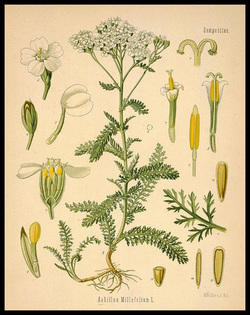

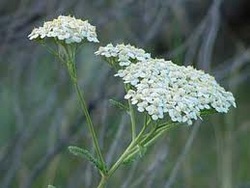
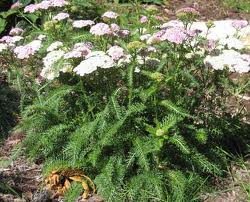
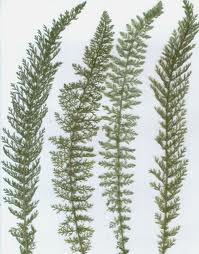
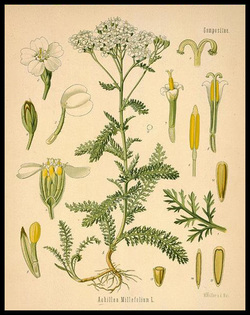

 RSS Feed
RSS Feed

